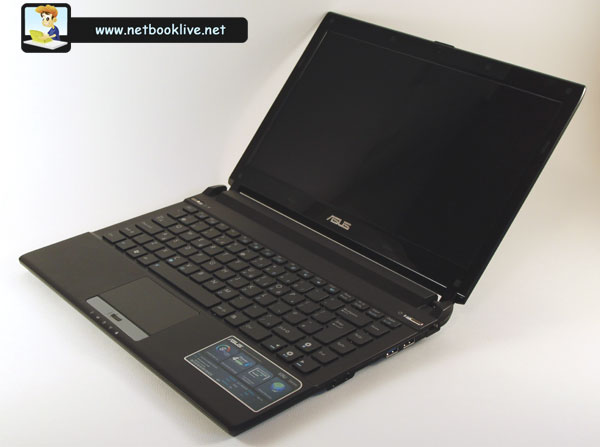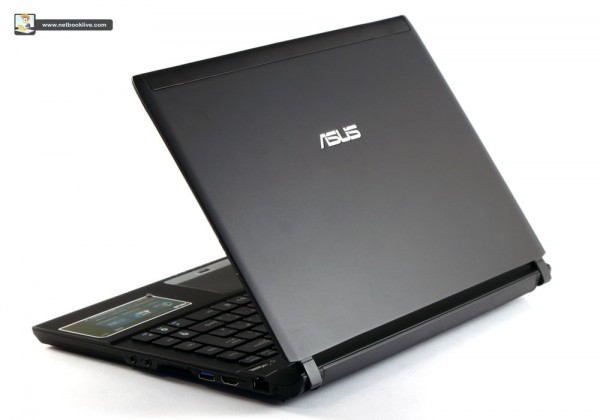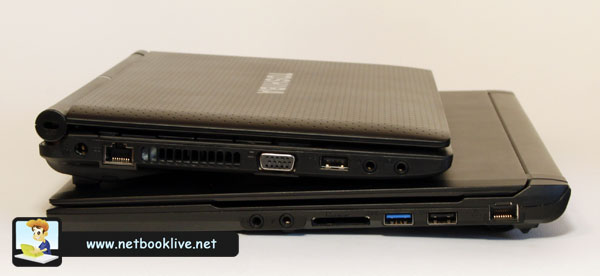These two laptops are part of the same generation, with the U36SD being the upgraded version of the U36JC. The later was launched in the first quarter of the year and packed decent hardware, being a decent contestant even now in the 13.3 inch niche.
The U36SD comes with a better processor (now on Sandy Bridge) and maybe, most importantly, one of the newest video cards for ultra portable computers.
But is it enough to make the newer entry a clear winner, or the U36JC can still deliver and save you a couple a bucks? Stay tuned and find out from our comparison review of the two, which will focus on build, design, performance, battery and more.
The specs
As we said, the U36SD was launched only a short while ago and it’s only natural that it comes with superior hardware. Our unit has a Core i5 Sandy Bridge processor, the Nvidia 520M video card, 6 GB of RAM, while the U36J can brag with a Core i5 CPU (previous generation), 3 GB of RAM and Nvidia Gforce 310M graphics. Full spec lists below.
Asus U36SD
- 13.3 inch display, 1366 x 768 px, LED backlit, glossy finish
- Core i5-2410M processor clocked at 2.3 GHz, with HyperThreading and Turbo Boost (2.9 GHz)
- hybrid graphics: Intel HD Graphics + Nvidia GT 520M + Optimus
- 6 GB of DDR3 memory
- 640 GB 5400 rpm HDD
- Bluetooth v2.1 + EDR (store version will come with BT 3.0, our review unit had BT 2.1), Wireless N, Gigabit Ethernet
- 2 x USB 2.0 , 1 x USB 3.0 , Card-reader, webcam, VGA and HDMI ports
- 6 Cell 4400 mAh 63 Wh battery (the final release will offer an 8 Cell 84 Wh battery, out test unit came with a 6 Cell though)
- Windows 7 Home Premium 64bit OS
- 12.9″ x 9.28″ x 0.76″
- 3.6 pounds with the 6 Cell battery (3.74 pounds with the 8 Cell battery)
Asus U36JC
- 13.3 inch LED backlit display, glossy, 1366 x 768 px resolution
- Intel Core i5-460M CPU clocked at 2.53 GHz
- 3 GB of memory
- Intel HM 55 Chipset
- hybrid graphics with integrated Intel HD Graphics and dedicated Nvidia GeForce 310M chip, controlled by Nvidia’s Optimus technology
- 500 GB 7200rpm hard drive
- Wireless N, Bluetooth 3.0, LAN
- 2 x USB 2.0 and 1 x USB 3.0 ports, HDMI, VGA, LAN, Audio, Webcam, Card reader
- 8 Cell 5600 mAh 84 Wh battery
- Windows 7 Home Premium OS
- measures 322 x 232 x 19 mm (12.9 x 9.3 x 0.8 inch)
- weighs 1.65 kg (3.6 pounds) with battery included
Build and design
The U36JC is covered in a magnesium alloy, with the chassis having a black or silver finish. The end result is great, as the computer is slimmer than many netbooks- 0.8 inch and pretty light- 1.65 kg. Also, the metal chassis is solid, and this will not feel like one of those shaky, skinny laptops.
The U36SD is even slimmer- 0.76 inch and has a similar magnesium alloy body, which feels even more sturdy and resistant than the finish on the U36JC. But there’s really nor difference between the two, as the exteriors are completely identical.

The U36JC is about 0.8 inches thick
Keyboard and touch pad
The U36JC has a full sized, Chiclet keyboard with plastic keys. It’s a workable keyboard, nothing too special, but it plays its part with minimal fuss. Keys are silent and don’t flex. The touch pad has the same magnesium finish you get on the chassis and is very pleasant to use, as the slightly rugged texture feels great on the finger. You get two mouse buttons, which are clearly differentiated and have a fingerprint sensor between them.
The keyboard and touch pad on the U36SD is identical, or at least highly similar to the one on the U36JC. A decent, plastic keyboard, with a precise touch pad. We couldn’t give either too many points, as most 13.3 inch machines try to offer better keyboards.
Display
The U36SD has a 1366 x 768 px resolution display with a glossy finish, which is a standard offering on Asus laptops for quite a while. Viewing angles are not necessarily very good (excepting frontal ones), but fortunately the screen can tilt back quite a bit and you can find decent angles with a little trial and error. The U36JC has basically the same screen. You’ll be able to enjoy good colors and brightness if you’ll look straight at the screen.

The U36SD has a matte, magnesium finish and is thinner than 0.8 inches
Hardware and performance
This is the chapter where the two kind of go their separate ways. The U36JC comes with a Core i5 460 M processor with a speed of 2.53 GHZ, 3 GB of RAM and a 310M graphics chip. It’s a mainstream configuration that can deal with some intensive computing, including some HD playback and rather modest gaming.
The U36SD, on the other hand, has a new generation Core i5-2520M processor (although you can go for Core i7 too, if you want), and comes with the Nvidia Geforce 520M video card, that has 2 GB of dedicated memory, and 6 GB of RAM. So it’s not a surprise that the later scores much better in synthetic tests. In 3D Mark Vantage, for example, the U36SD scored 2292, while the U36JC settled for 1038.
Basically though, both devices are pretty fast, with the newer generation U36SD offering similar performances in terms of RAW CPU computing power, but significantly faster graphics. All these while being more energy efficient, but also while getting a bit hotter.
For more details on performances and test results, see the dedicated reviews for the U36JC and the U36SD models.

A 10 inch netbook is chunkier than the U36JC
Connectivity and ports
The two laptops have the same connectivity options, including Wireless N, Bluetooth and Gigabit LAN. As for ports, both machines have a USB 3.0 port and HDMI port, alongside a more classic plateau of USB 2.0, card reader and audio jack.
Heat, noise, speakers and others
The U36JC comes with a pair of modest speakers, which we would recommend more for chatting, rather than use for music or movies. The U36SD tries to push it up a little and comes with Altec Lansing speakers and SRS technology, but quality is not too impressive. As for heat, the U36J rarely gets too hot; after some 1080p playback, the bottom gets warm, but the lid stays really cool. The U36SD gets hot much faster, with the left side of the keyboard and bottom getting very hot, with a maximum of 80 degrees Celsius, when running some games. Still, it runs overall decently cool during everyday use.
As for fans, the U36JC is quieter, considering that fans kick in only from time to time, as the laptop doesn’t get too hot. The U36SD is hard at work more often and while gaming and HD playback, you’ll hear the fans working. Both laptops have a modest web cam, which should be OK for Skype, but not for taking quality pics or something.
Battery life
The U36SD has an 8 cell battery that might offer around 6 hours of autonomy on normal use, which can contain browsing, music, some productivity apps. In more intense circumstances, like playing or watching HD content, you’ll drain the juice maker in a little over 4 hours. Of course, if you’ll keep the WiFi module off and brightness low, you might get as much as 8 hours of autonomy.
The U36JC, on the other hand, has a similar 8 cell battery and can go on a single charge for a maximum of 5-6 hours. This is not very impressive, considering that the U36SD, with more demanding hardware, can get more out of the same type of battery.
Prices and availability
The Asus U36JC goes for about $800 right now, which is about 100 bucks less than the price it had around 6 months ago. There’s also a version which is a bit more expensive, $819.99, which gives 6 GB of RAM.
The U36SD goes for $999 and it’s available only for preorder for the moment- the version that we’ve tested, with the i5 chip. There are also Core i3 and i7 versions which will cost a little less and a little more than this “base” model.
Final thoughts
As you might expect it, the U36SD offers a better computing experience because it simply comes with superior hardware. It doesn’t mean that the U36JC can’t flip flap; it surely can, but doesn’t offer the same gaming and multitasking flexibility as the newer model. Screen, keyboard, design are kind of similar, considering that the two use almost the same skeleton- still, we noticed that the U36J doesn’t get as hot and noisy as the U36SD and has a lower price tag.
In the end, if you want great performance for a 13.3 inch machine, you’ll have to splash the cash on the U36SD. But if you don’t need all that muscle, the U36JC is still a very competitive machine, with a likewise asking price.
Still, you do have to know that the U36SD is in fact the successor of the U36J line and the later will soon get out of stock. But these being said, there’s really no reasons why one would consider the older version, with an outdated hardware platform, over the recent U36S line.














Guest
August 8, 2011 at 6:38 pm
Hi,
Is the u36sd’s noise level really noticeable? I am usually sensitive to this, and this is pretty much the only thing that keeps me from pre-ordering it.
Mike
August 9, 2011 at 7:55 am
Should be OK in everyday use. Not so much when running full hd content or games though
Guest
August 9, 2011 at 8:20 am
Really annoying or just noticeable? That seems to be problematic for a laptop which has the power to run this kind of stuff.
Hudecek Ondrej
August 11, 2011 at 8:56 am
Hi guys, thx for your reviews about asus u36sd – sometimes I have feeling like you’re only one who are posting about this one – IMHO it will be kinda bestseller for some time :).
Anyway just for this comparison – you stated above in the specs that – JC comes with bluetooth 3.0 whereas SD with 2.1 and if its really true could be good to mention it in “Connectivity and ports”. For someone worth to know maybe ;). But what Ive seen on various sellers websites in specs – SD has usually 3.0 as well.
cheers
Ondrej
Mike
August 11, 2011 at 12:11 pm
Ondrej, our tested unit came with 2.1, but I think the final version will have 3.0 . I’ll add this to the section
Hudecek Ondrej
August 11, 2011 at 9:13 am
Yeah and Ive forget to mention the difference – SD at least for our market comes (Czech Republic) with a hybrid harddrive – 500 GB HDD + 4 GB SDD – far much faster solution in final than 7200 rpm’s HDD.
Yeah and one mistake in The Specs – you stated that SD has 6 cell battery but obviously you’ve had with 8 cell.
Ondrej
Mike
August 11, 2011 at 12:16 pm
Actually, the unit I reviewed here on the site came with a 6 Cell, it was a sample. The ones you’ll get in stores will offer an 8 Cell battery like you said. I’ve also added that clarification to the specs list 😛
Hudecek Ondrej
August 19, 2011 at 12:49 pm
Yes, You mentioned there in specs but afterwards in Battery Life is stated about SD 8-cell battery so I thought that… Anyway I must to admit that it is much valuable info than you would review about 6 cell you have had in SD in comparison to 8-cell of JC. In any case its strange why producers do this differences in case of each market…
Sry maybe I seem to be annoying but I really appreciate your work and what’s more next week I will get u36sd so im a bit impatient. 😉 Keep up the good work guys! Best greets!
guest
December 22, 2011 at 7:07 am
Hi. I just saw a newer model of this computer: U36SD-XH7. It is being sold to about $1260. It seems to have superior specs: i7, 8gb memory, 160gb ssd. However, I couldn’t figure out why it is so cheap and even more curious why isn’t there any review about it.
Is there anything wrong about this computer that I don’t now about because I am seriously considering buying this one?
Alexander
August 4, 2012 at 4:42 am
Hi guys. Since the third gen Ivy-Bridge processors are now rolling out, I was wondering if there are any signs for a U36S/U36SD successor?
My Asus F8Vr has seen better days and looking to upgrade. Something like the U32VD doesn’t quite seem to have the grunt or flair.
Andrei Girbea
August 4, 2012 at 5:40 pm
I haven’t heard anything about it, but I’m going to specifically ask Asus about that. Will get back if I find something worth sharing 😉